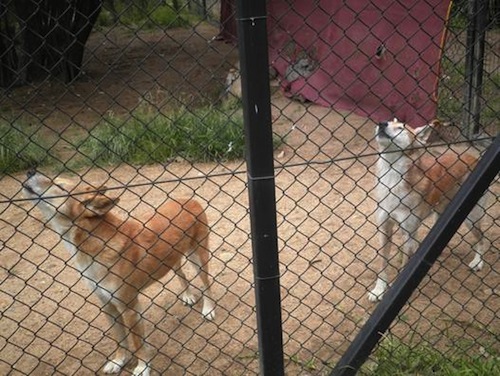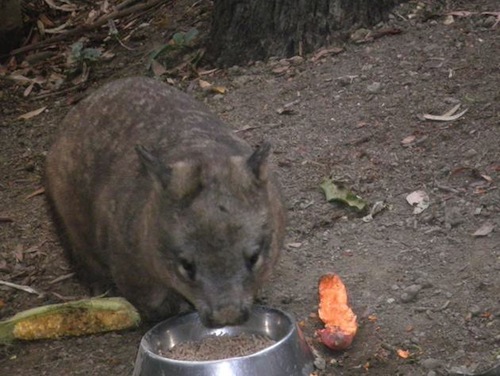G'day maties! Welcome once again to my tour of exotic Australian animals. The three animals I'm showcasing in this article are the rainbow lorikeet, the dingo and the southern hairy nosed wombat. All the photos in this particular article were taken by me at a wildlife sanctuary my family recently visited. I'm going to share with you photos, facts and stories about the creatures. Enjoy!

The rainbow lorikeet truly lives up to its name with the rainbow colored feathers it exhibits. The head is usually blue or violet, the belly is yellow and orange, the beak and eyes are red and the tail and wings are green- most of the colors of the rainbow. These birds are parrots with a dash of color and a serious attitude. They are notorious for destroying fruit crops and making loud screeching noises while clowning around in flocks.
Despite this, the birds mainly eat nectar and pollen from flowers. It's not uncommon to find rainbow lorikeets in backyards with flowering native shrubs such as bottlebrushes, grevillia and banksia that have a safe environment for the birds to feed. They can hang upside down like monkeys and weave between the branches like acrobatics in order to eat the pollens.
Usually they travel in pairs, feed in groups of about 20 and rest at dusk in groups of hundreds in trees. During the breeding season in Spring a male lorikeet will flap his wings energetically and bounce up and down to attract female attention. Once he is found by a female they will mate and the female usually lays around 2 eggs in their nest in the bottom of a tree hollow. It will take about 25 days for them to hatch, and once they do chicks which do not yet have the brightly colored plumage will emerge. Some people keep rainbow lorikeets as pets!

The dingo looks a lot like the average, medium sized dog with a yellow coat and bushy tail. In some parts of Australia some people keep tame dingoes as pets. Dingoes are well known as pure native Australian animals, however this is not true. It's believed that they were introduced to Australia over 3,500 years ago and originated in Asia. There is a theory that dingoes were brought to Australia by Aboriginals who traded with Indian traders. Aborigines kept dingoes in their camps and the dogs hunted with the men. In modern times they are extremely rare outside of Australia.
Dingoes are carnivorous animals that hunt mainly reptiles and mammals although they will eat almost anything. Wild dingoes do not bark, but they do growl and howl to communicate. Dingoes will howl to announce that a territory is theirs. When my family visited a wildlife sanctuary we heard howls that sounded almost identical to wolves howling in the distance. The picture below is one I took of two dingoes with their heads high in the air howling at the sky.

A pair of dingoes will stay together for life. Breeding occurs once a year during colder months. Female dingoes give birth to a litter of around 4-8 puppies in a den. At around 3 weeks old the pups leave the den and are taught by their parents how to hunt food. The parents catch the prey but leave it somewhere close by to the den for their young to hunt down. Unfortunately these animals are endangered. Partly because of habitat loss and partly because they are considered pests and killed by farmers who have their livestock preyed on.

This next photo is of an Australian marsupial, the wombat, which is the largest burrowing mammal. There are three species of wombat: the Common Wombat, the Northern Hairy-nosed wombat and the Southern-hairy nosed wombat (which is what is shown in the photo above). Both types of hairy-nosed wombats are an endangered species due to loss of habitat. The northern hairy-nosed wombat is more endangered than the panda.
Wombats use their long claws to dig burrows where they will be safe from predators and harsh weather. It's not uncommon for a wombat to have several burrows in its territory, all extensive with a system of entrances and chambers. They emerge at night or on cool days to feast on any grasses, roots, herbs, and other plants they may find. On most occasions wombats give birth to one joey. The joey will be kept safe and snug in the mother's pouch until it becomes old enough to head outdoors. An interesting fact about the wombat is that the female's pouch faces backwards to prevent dirt from entering while burrowing in the ground.
Wombats may appear slow and sluggish but really they are very alert and speedy. A wombat can run a short distance at a speed of up to 40 km/hr (25 mph). That's as fast as the fastest Olympic runners! Another impressive thing about wombats is they are incredibly strong for their size. Also, like mentioned above they are extremely handy diggers. A wombat can out dig a man with a shovel. If there really was such a thing, that would truly be gold medal standard at the animal Olympics!
All these unique and exotic animals are gold medal worthy. It's a pleasant surprise to spot a flash of rainbow colored feathers frolicking up in a tree. It's interesting to hear about people who've managed to tame dingoes from an early age and keep them as pets. When I was little I was very fond of a popular book called "Wombat Stew". Be on the lookout for next week; I am showcasing three more animals then!
Author's Note: If you would like to discover further information about these animals go to the sources below.
Rainbow Lorikeet:
http://www.australian-information-stories.com/rainbow-lorikeet.html
http://www.australiananimallearningzone.com/rainbow-lorikeet.htm
http://bioweb.uwlax.edu/bio203/s2008/runde_sama/Interesting%20Facts.htm
Dingo:
http://www.kidcyber.com.au/topics/dingo.htm
http://www.dogbreedinfo.com/dingo.htm
http://dingo.livingin-australia.com/dingo-facts.html
Southern Hairy-Nosed Wombat:
http://www.kidcyber.com.au/topics/wombat.htm
http://www.australiazoo.com.au/our-animals/amazing-animals/mammals/?mammal=wombats&animal=southern_hairy-nosed_wombat
http://www.perthzoo.wa.gov.au/animals-plants/australia/australian-bushwalk/southern-hairy-nosed-wombat/